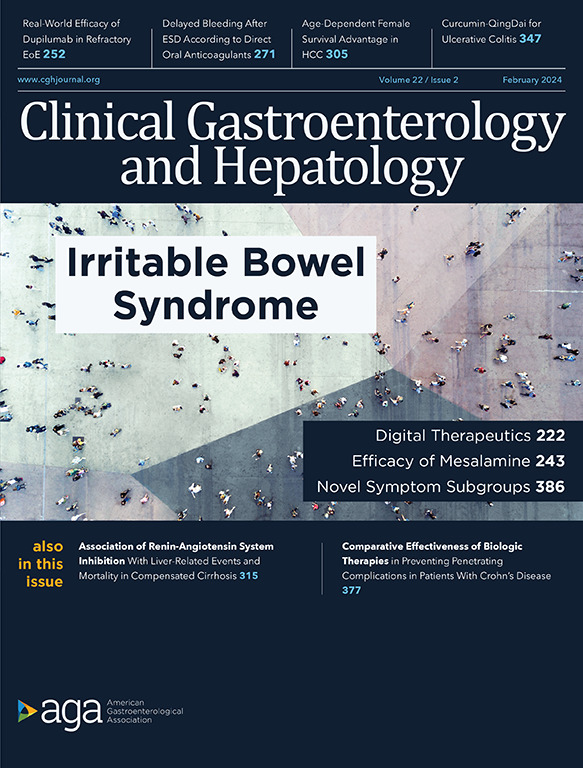Real-world Effectiveness of Fecal Microbiota Transplantation for First or Second Clostridioides difficile Infection
IF 11.6
1区 医学
Q1 GASTROENTEROLOGY & HEPATOLOGY
引用次数: 0
Abstract
Background & Aims
Clostridioides difficile infection (CDI) is associated with high mortality. Fecal microbiota transplantation (FMT) is an established treatment for recurrent CDI, but its use for first or second CDI remains experimental. We aimed to investigate the effectiveness of FMT for first or second CDI in a real-world clinical setting.
Methods
This multi-site Danish cohort study included patients with first or second CDI treated with FMT from June 2019 to February 2023. The primary outcome was cure of C. difficile-associated diarrhea (CDAD) 8 weeks after the last FMT treatment. Secondary outcomes included CDAD cure 1 and 8 weeks after the first FMT treatment and 90-day mortality following positive C. difficile test.
Results
We included 467 patients, with 187 (40%) having their first CDI. The median patient age was 73 years (interquartile range [IQR], 58–82 years). Notably, 167 (36%) had antibiotic-refractory CDI, 262 (56%) had severe CDI, and 89 (19%) suffered from fulminant CDI. Following the first FMT treatment, cure of CDAD was achieved in 353 patients (76%; 95% confidence interval [CI], 71%–79%) at week 1. At week 8, 255 patients (55%; 95% CI, 50%–59%) maintained sustained effect. In patients without initial effect, repeated FMT treatments led to an overall cure of CDAD in 367 patients (79%; 95% CI, 75%–82%). The 90-day mortality was 10% (95% CI, 8%–14%).
Conclusion
Repeated FMT treatments demonstrate high effectiveness in managing patients with first or second CDI. Forwarding FMT in CDI treatment guidelines could improve patient survival. ClinicalTrials.gov, Number: NCT03712722


粪便微生物群移植治疗首次或第二次艰难梭菌感染的实际效果。
背景和目的:艰难梭菌感染(CDI)与高死亡率有关。粪便微生物群移植(FMT)是一种治疗复发性 CDI 的成熟疗法,但用于首次或第二次 CDI 的治疗仍处于试验阶段。我们的目的是在真实的临床环境中研究粪便微生物群移植治疗首次或第二次 CDI 的有效性:这项多地点丹麦队列研究纳入了 2019 年 6 月至 2023 年 2 月期间接受 FMT 治疗的首次或第二次 CDI 患者。主要结果是最后一次 FMT 治疗八周后艰难梭菌相关性腹泻(CDAD)治愈。次要结果包括首次 FMT 治疗后 1 周和 8 周 CDAD 的治愈率,以及艰难梭菌检测阳性后 90 天的死亡率:我们共纳入了 467 名患者,其中 187 人(40%)为首次 CDI 患者。患者年龄中位数为 73 岁(四分位数间距 (IQR) 58-82 岁)。值得注意的是,167 人(36%)患有抗生素难治性 CDI,262 人(56%)患有重症 CDI,89 人(19%)患有暴发性 CDI。首次接受 FMT 治疗后,353 名患者(76%,95% 置信区间 (CI) 71-79%)在第一周治愈了 CDAD。第八周时,有 255 名患者(55%,95% 置信区间为 50-59%)维持了疗效。在没有初始疗效的患者中,367 名患者(79%,95% CI 75-82%)通过重复 FMT 治疗总体治愈了 CDAD。90天死亡率为10%(95% CI 8-14%):结论:重复 FMT 治疗对首次或第二次 CDI 患者的治疗效果显著。将 FMT 纳入 CDI 治疗指南可提高患者的生存率。
本文章由计算机程序翻译,如有差异,请以英文原文为准。
求助全文
约1分钟内获得全文
求助全文
来源期刊
CiteScore
16.90
自引率
4.80%
发文量
903
审稿时长
22 days
期刊介绍:
Clinical Gastroenterology and Hepatology (CGH) is dedicated to offering readers a comprehensive exploration of themes in clinical gastroenterology and hepatology. Encompassing diagnostic, endoscopic, interventional, and therapeutic advances, the journal covers areas such as cancer, inflammatory diseases, functional gastrointestinal disorders, nutrition, absorption, and secretion.
As a peer-reviewed publication, CGH features original articles and scholarly reviews, ensuring immediate relevance to the practice of gastroenterology and hepatology. Beyond peer-reviewed content, the journal includes invited key reviews and articles on endoscopy/practice-based technology, health-care policy, and practice management. Multimedia elements, including images, video abstracts, and podcasts, enhance the reader's experience. CGH remains actively engaged with its audience through updates and commentary shared via platforms such as Facebook and Twitter.

 求助内容:
求助内容: 应助结果提醒方式:
应助结果提醒方式:


